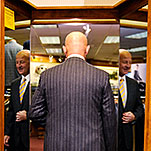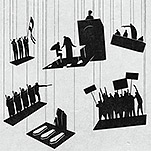SÃO BERNARDO DO CAMPO, Brazil — Over more than a half-century of production here, the Volkswagen Kombi, or minivan, has been many things to Brazil: ambulance, fire truck, hearse, food vendor, impromptu furniture store, school bus and sugar-cane juice dispenser — to name just a few. For most people in this nation of immigrants it is a Brazilian car with distant German roots.
Op-Ed Columnist
The Kombi Madeleine
By ROGER COHEN
Published: November 7, 2013
Related in News
-
International: Long, Strange Trip Ends for a Symbol of the ’60s (October 6, 2013)
Connect With Us on Twitter
For Op-Ed, follow @nytopinion and to hear from the editorial page editor, Andrew Rosenthal, follow @andyrNYT.
What the Kombi, a mobile box with the driver positioned almost flush with the front of the vehicle and the engine flush with the back, has not been in Brazil is the hippie van par excellence, symbol of the trail to New Delhi, flower power, the sexual revolution, truckin’ on, torrid nights and the sounds of the Grateful Dead (until of course the cassette player got stolen because somebody somehow forgot to close a window).
The romantic spray-painted minibus of San Francisco or Hay-on-Wye is the plain white workhorse of São Paulo. So it goes. Legends come in many forms. Storytelling embellishes them. Put a lot of cheap interior space on wheels, however slow-moving, and people the world over — from Deadheads to plumbers — will find plenty of ways to fill it.
I had to make the pilgrimage. The very last Kombinationsfahrzeug, to honor the so-called T2 (or Type 2) with its full name, will be produced at the end of next month, the victim of Brazilian legislation making air bags and anti-lock braking systems obligatory from Jan. 1, 2014. A car that has skipped four generations of automotive development, dismissed as so much techno-fluff, just does not have room for these pesky innovations.
The most beautiful of ugly creations has been true in its versatility to its “combined vehicle” billing, a car as successful as it is basic, manufactured in Brazil with little substantial change since Sept. 2, 1957, although in 2006 it did get a new water-cooled flex-fuel engine to replace the air-cooled “boxer” original (the only factory option was rear-window de-misting). In all, more than 1.5 million units have been produced here, in addition to the 7.9 million or so that were made in Germany, Mexico and elsewhere.
I asked Gilberto dos Santos, a Volkswagen spokesman, why it has done so well. “Because it’s enough,” he said.
Enough: Such a gorgeous, forgotten concept in the age of ultra-sophistication, ultra-excess and packaged ultra-experience. The Kombi is spare to the point of minimalism.
Power steering? Forget it. Air conditioning? Forget it. Irritating beep-beep seat-belt reminder? Forget it. Reverse parking sensor? Forget it. Electric windows? Forget it. Infinitely adjustable driving position? Forget it. But, aah, how perfect is the ventilation from those simple little sail-shaped, push-out front windows (easily pushed-in by thieves after the sound systems blasting the Flying Burrito Brothers’ “White Line Fever”).
Less is more, as anyone who has compared Johnnie Walker Black Label whisky to Double Black knows. It is useful to be reminded, as the Kombi reminds you, that a car is a metal container whose function is to get you from A to B. It is enough.
It is also wondrous to find Proust’s madeleine, after which we all seek in order to defeat time, and particularly so as we grow older, in the form of a light-blue-and-white Kombi Last Edition in São Paulo state.
The weight of the huge steering-wheel posed almost flat, the driving position above it and forward of the front axle, the view unobstructed by anything as superfluous as a hood, the crude handbrake, the nothing dashboard, the painful uphill progress — everything (except a windscreen no longer split in two) hoisted me out of Brazil and, as if by magic, placed me back four decades at the wheel of a Kombi on the road from London to Kabul and Mazar-i-Sharif by way of Iran, before Islamic revolutions and sundry wars cut off that particular hippie dream, its roads without maps, its chance encounters, its random meanderings and its lucky escapes. We called our minibus “Pigpen,” after the keyboardist of the Grateful Dead, who had died just before we set out, and of course we had it painted with naïf scenes along the sides at a Kabul truck depot, and a royal straight flush on the front.
Our stay in Afghanistan coincided with the coup that deposed King Mohammad Zahir Shah after a 40-year reign and set in motion the enduring Afghan agony, but we paid little attention, being diverted by matters such as sitting on the heads of the Buddhas of Bamiyan, since destroyed by the savagery of the Taliban, and contemplating a lovely strip of fertile land along a river against a red and arid backdrop, or, later, gazing at the white doves of Mazar in the bleary dawn.
“How do you like it?” asked Luis Felipe Figueiredo of Volkswagen.
I was speechless. It is wonderful — it is important — it is vital — to be transported.

















